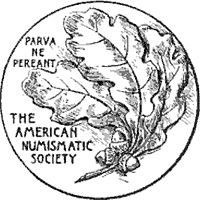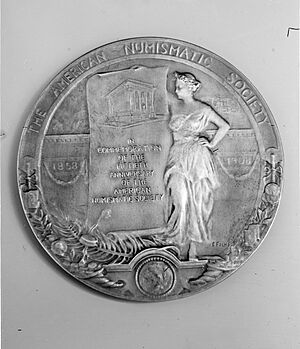American Numismatic Society facts for kids

Logo from a 1918 publication
|
|
| Founded | 1858 |
|---|---|
| Type | Museum and Research Institute |
| Focus | Numismatics |
| Location |
|
|
President
|
David Hendin |
|
Executive Director
|
Ute Wartenberg |
| Affiliations | American Council of Learned Societies, American Alliance of Museums, International Numismatic Council |
The American Numismatic Society (ANS) is an organization in New York City. It focuses on studying coins, money, medals, and similar items. Founded in 1858, it is the only museum in America just for collecting and studying these objects. The ANS has almost one million items in its collection. It also has the world's largest library of books and information about numismatics. Numismatics is the study of coins and money.
Contents
What the ANS Does
The American Numismatic Society studies coins, money, and medals from all over the world. They look at items from ancient times to today. Their main office in New York City holds the best collection and library for numismatics in the United States.
These resources help experts, collectors, and anyone interested in coins to learn more. The ANS is part of the American Council of Learned Societies. This means it is connected to other important museum and cultural groups.
Their Main Goal
The main goal of the ANS is to be the top place for studying and sharing knowledge about coins, money, and medals. They see these items as important historical and artistic objects. They want everyone to appreciate them.
Where the ANS Has Been
The ANS and its collections have been in several places in New York City. At first, meetings were held in people's homes. One early meeting was at the home of Augustus B. Sage, a founding member.
For many years, the ANS rented spaces in different buildings. These included the Cooper Union and the Bible House. In 1904, Archer Milton Huntington became president. He helped the society move to Audubon Terrace. They first shared space with the Hispanic Society of America. Then, in 1907, they got their own building.
In 2003, the society moved to a new building on Fulton and William Street. Since 2008, the ANS has been at its current home. It is located at 75 Varick Street near Canal Street in downtown Manhattan.
The Collection
The ANS has over 800,000 coins, medals, and paper money items. These come from all time periods and cultures. In many areas, the ANS collections are the most complete in the world.
The collection includes very old items from Ancient Greece and the Roman Republic. It also has many coins from America, Europe, East Asia, South Asia, and Islamic countries. These coins date from 700 BCE to today. The collection also has paper money and other non-coin money. There are also medals and decorations from as early as 4000 BC.
The ANS team takes care of, studies, and records this huge collection. They keep their online database called MANTIS updated. They also add images to it. This online database is very helpful for studying numismatics. It is one of the biggest of its kind and anyone can use it.
Online Resources for Learning
The ANS offers many numismatic research tools and information online. They share their own items and work with other groups. For example, the ANS worked with the Institute for the Study of the Ancient World. Together, they created OCRE. This stands for "Online Coins of the Roman Empire." This project aims to list every known type of Roman Imperial Coin. It also links them to examples in major online collections.
The ANS also helps with Nomisma.org. This is a project that helps organize information about numismatics online. Similarly, the Hellenistic Royal Coinages project (HRC) does something similar. It focuses on coins from the empire of Alexander the Great and his kingdoms. This includes the Seleucids in the Near East and the Ptolemies in Egypt.
Exhibitions and Displays
The ANS has a small exhibition space at its main office in Manhattan. This space is open to the public. The ANS also lends items from its collections to other museums and exhibitions. Many ANS objects can be seen at The Metropolitan Museum of Art. You can also find exhibitions with ANS objects all over the world.
The Library
The ANS library has over 100,000 items. It is one of the most complete collections of numismatic books and materials. This includes books, magazines, auction catalogs, and old papers. A special part of the library is the Rare Books Room. It has a unique collection of very old books about coins.
Awards and Honors
The ANS gives several awards to people who help numismatics and the society.
The Huntington Medal Award is given every year. It honors Archer Milton Huntington, who was very important to the ANS in the early 1900s. This award recognizes people who have made great contributions to numismatic study throughout their careers. The first award was given to Edward T. Newell in 1918.
The Saltus Medal Award is named after J. Sanford Saltus. He started this award in 1913. This award goes to sculptors "for distinguished achievement in the field of the art of the medal." At first, only American artists could receive this medal. Since 1983, artists from other countries can also get it. The 2011 award went to Portuguese artist João Duarte. You can find past winners on the List of Saltus Award winners.
Graduate Seminar
In 1952, the American Numismatic Society started the Eric P. Newman Graduate Seminar in Numismatics. This training program in numismatics happens every summer. Many people who attended this program now work in academic jobs.
History of the ANS
A group of collectors in New York City formed the ANS in 1858. This was a time when many learned societies were being created. The first meeting of collectors was in March 1858. However, the society considers April 6, 1858, as its official start date. That was the day its first rules were approved by the members. That same month, the society received its first coin.
In 1865, it became known as the American Numismatic and Archaeological Society (ANAS). In 1907, the name was changed back to the original one.
Early founders included Edward Groh, James Oliver, and Augustus B. Sage. Benson Lossing wrote in 1884 that the society's main goals were to study numismatics and American archaeology. They also wanted to collect coins, medals, and old artifacts. Later, the ANS changed its focus to mainly study all aspects of coins and medals.
Under strong leaders, the ANS grew into a major international center for numismatic research. One president, Archer M. Huntington, was from the family that built the Southern Pacific Railroad. He was also a serious collector. He gave the society land at 155th Street and Broadway. He also helped pay for the new building, which opened in 1908. In 1929, Huntington paid for the building to be made twice as big.
From 1916 to 1941, Edward T. Newell was president of the ANS. He was an expert in Greek coins. He helped the society become known worldwide. He also gave his huge personal coin collection to the society.
In the second half of the 1900s, the society became the top numismatic research place in the United States. Its collection of almost one million objects is one of the largest in the world. It is a great resource for students. Its unique library of over 100,000 items is the most complete collection of numismatic information available.
The society's Eric P. Newman Graduate Seminar in Numismatics started in 1952. It continues today as a training program. Many of its past students are now scholars in academic jobs. This includes some of the society's current staff. The society also offers different scholarships and grants. These help promote research in numismatics and encourage people to use the collections.
Notable Members
- Agnes Baldwin Brett
- Ernest Babelon
- Harry W. Bass Jr.
- Abram Belskie
- Granville Carter
- Eugene Daub
- Thomas Dunn English
- Roger Curtis Green
- Philip Grierson
- Kenneth W. Harl
- David Hendin
- Robert Hewitt Jr.
- Urban T. Holmes Jr.
- Archer M. Huntington
- Edward Theodore Newell
- Eric P. Newman
- Stephen Hyatt Pell
- Russell Rulau
- William Herbert Sheldon
- Ute Wartenberg
See also
- List of Saltus Award winners


